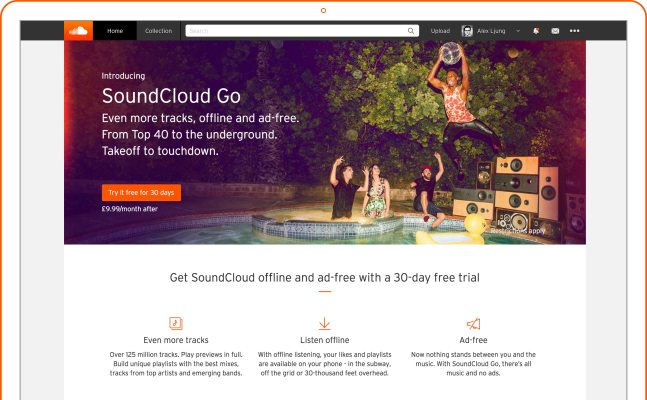Now that SoundCloud has inked licensing deals with all the big music rights holders, the startup is wasting no time rolling out subscription services and advertising to a wider number of markets to better monetize its 175 million users and compete better against the likes of Spotify, Deezer, Apple Music and the rest.
The music-streaming company — sometimes referred to as the YouTube of audio for its wide array of user-generated content — is today expanding its SoundCloud Go premium subscription service to the U.K. and Ireland, a month after first launching it in the U.S. As with the U.S. version of Go, users will have ad-free access, plus a Spotify-style selection of millions of premium tracks alongside the wider SoundCloud catalog of music and podcasts — some 125 million tracks in all for a fee of £9.99 or €9.99 per month after a 30-day free trial (the U.S. version costs $9.99 per month).
One month from the launch of Go, SoundCloud is not giving away much about how it has been received so far in the U.S., the only market where it has launched so far. “The overall feedback is extremely positive, and we’re hugely excited,” was the most that Eric Wahlforss, SoundCloud’s co-founder and CTO, would say in an interview. Of course, there are likely a lot of people who have signed on for the free trial, so it will be a waiting game to see how many stay.
At the same time, to pick up more audience, Wahlforss said SoundCloud is looking for ways of leveraging its social media credentials. (On SoundCloud, in addition to being able to follow people, you can tag tracks with your own insights and respond to comments from others, creating a kind of conversation unique to the platform.)
The company has been working with Twitter to make audio content playable in-stream (most recently, SoundCloud started working in Twitter Moments).
And Wahlforss also brought up Snapchat as “a super interesting company” for being “very real time and authentic, how we want and like SoundCloud to feel as well,” and for being compatible in another way, too: “There are very few companies that have over 100 million uniques with a lot of them millennials.”
SoundCloud and Snapchat both do. No comment on whether the two are working together, but this sounded like a very strong hint that if they are not already, SoundCloud wants to be.
Native ads turn creators into creatives
And for those who opt to listen to SoundCloud for free, brace yourselves for ads of many formats.
SoundCloud said these will include audio spots; in-stream “native” ads; promoted profiles; and creator partnerships. I asked SoundCloud to clarify what “native ads” will look like and it seems that “native” in this case will not necessarily be a revival of advertising jingles by musicians.
“Brands are choosing either existing tracks from creators or may be able to inspire a track, but it won’t be a direct endorsement,” a spokesperson told me.
Regardless, the main idea, it seems, is to not just put in more advertising, but to do it in a way that ties in the artists themselves — 12 million and counting on the SoundCloud platform today — so that if they choose, they can use ads as an extra revenue stream alongside whatever royalty deals they may have in place around their actual music and other audio content.
Alongside the ability to track music and choose what tracks are part of SoundCloud’s free and paid tiers, the ads become something that artists can also control. “The introduction of advertising will ensure listeners can continue to experience SoundCloud for free, as well as offer creators the opportunity to be paid for the work that they share,” the company noted.
This is also an attempt to respond to a wider issue around streaming services like SoundCloud (and others), which have been criticized and shunned by some artists who believe that they are not getting paid fairly for their work.
Ads and subscriptions are SoundCloud’s latest efforts to generate revenues, after initially starting out with SoundCloud Pro. Aimed at creators rather than consumers, Pro comes in two tiers of $7 and $15 per month and gives people the ability to upload more than the standard 12 hours of audio, plus analytics and more content controls.
